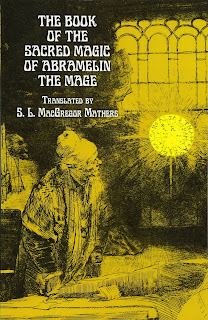The gris gris tradition first arrived in New Orleans in the 1720s with the arrival of the first Senegambian slaves. It is a unique characteristic of New Orleans Voodoo and an interesting and important facet of New Orleans' cultural history. The knowledge of making charms, amulets, wangas, and poisons - all part of New Orleans gris gris - was brought to New Orleans by the Muslim marabouts and by traditional Africans from Central Africa.
Gris gris is mostly known as akin to a mojo bag, but as I have written about in Hoodoo and Conjure Quarterly, on my various blogs and Examiner.com column and in the Voodoo Hoodoo Spellbook, it comes in many forms. "Gris gris" can be a noun and a verb just like the word "hoodoo". Gris gris can consist of animal parts, powdered insects and herbs, can be placed in a bag or a toby and can be deployed in foot track magic. It can smeared on door knobs, sprinkled on floors, sheets, and clothing, and blown in the face to be inhaled by some unfortunate target. Gris gris can be made and used as a tool using the principles of sympathetic and contagious magic, and it can be made to house a spirit. As such it is alive upon the completion of its creation. Gris gris can be used for positive works such as healing and relationships, drawing money and self empowerment, and it can be used for more nefarious purposes like revenge and harm. It even has a history as being used as a weapon of war (see Diouf, 1998; Hall, 1992; and Walter & Friedman, 2004 for more historical discussion about gris gris used defensively).
One form gris gris takes that is never written about is its use in liquid form. In the past, when gris gris was used as a means of self defense against cruel slave masters, or as a weapon of war, it was made into a potion or liquid. One formula included snake venom mixed with copper and clay into which talons of birds of prey were dipped and used as a weapon. Another way consisted of writing words of power onto a smooth surface and then washing them off with water into a cup and clandestinely given to a target. Its use as a poison is no longer practiced but there are documented cases of its use in such a fashion dating as far back as the early 1720s (Superior Council, 1729).
I love this liquid means of deployment - how ingenious! I like it so much I have adapted the method for putting the gris gris on a lover who consents to it. Check it out.
Liquid Gris Gris
This gris gris should only be done with the express consent of the target person. It can be used in a lover's pact to profess one's commitment to the relationship, for example.First, you have to make an edible ink. To do this, use a cup of the juice of blackberries or pomegranates and cook it down on the stove on low heat with a bit of sugar. Place the liquid in a saucepan and cover it, cook on medium heat and slowly bring to a boil. Then, simmer it and stir the liquid uncovered for 15 to 20 minutes, or until it reduces down to approximately 2 tablespoons of a syrupy consistency. This takes quite some time to do so be patient...but it also gives you time to pray your intention over the ink and to focus. If your partner is present when you are making the ink, which I highly recommend - both parties should be part of the process - take turns stirring the potion and speaking kind and loving words to each other, and speak of the improvements in your relationship you would like to make.
Once the potion is of a thick consistency take a chopstick and dip it into the ink and write on a mirror an agreed upon pact, such as "forever faithful, honest and supportive". This pact can be written in Theban (the Witch's Alphabet) to enhance the magical quality of the work. In the past, passages from the Koran would be used, or the words would be written in Arabic, or in symbols of the particular African tradition. In New Orleans, this has been replaced by some practitioners with the use of the Theban Alphabet. Allow the pact to harden.
Using the juice of a pomegranate or red wine, gently wash the words off of the mirror into a glass. Take turns sipping from the love gris gris you have just made together. The pact has been internalized both spiritually and physically and will have a profoundly positive psychological effect on the relationship as a result.







